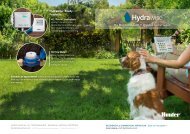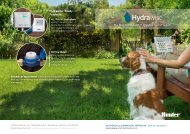Hunter Residential Sprinkler System / Irrigation system design guide - Calgary irrigation
Residential Irrigation Service and Design Guide for underground sprinklers. Learn how to design, install, service, repair and winterize your underground sprinkler system. Irrigation Calgary. Lawn irrigation. Underground sprinklers Calgary
Residential Irrigation Service and Design Guide for underground sprinklers. Learn how to design, install, service, repair and winterize your underground sprinkler system. Irrigation Calgary. Lawn irrigation. Underground sprinklers Calgary
Create successful ePaper yourself
Turn your PDF publications into a flip-book with our unique Google optimized e-Paper software.
POINT OF CONNECTION<br />
Main Line<br />
1. Determine the location for the <strong>system</strong> point of<br />
connection (P.O.C.). It should be between the water<br />
meter and any pressure regulator on the structure.<br />
2. Draw a line connecting all the manifolds together, and<br />
then draw a line connecting this line to the P.O.C.<br />
3. The main line should generally be one pipe size larger<br />
than the largest lateral line.<br />
Point of Connection<br />
Non-Freezing Climates<br />
Use a brass compression tee to hook your sprinkler <strong>system</strong><br />
to the household water supply line. You may hook up to<br />
copper, PVC, or galvanised iron service lines without having<br />
to solder or thread any pipe. Most areas require some type<br />
of backflow preventer to protect drinking water. Copper<br />
pipe may be required between the P.O.C. and the backflow<br />
preventer. Always check the local building code or with the<br />
local permitting agency for the requirements in your area.<br />
Freezing Climates<br />
If the installation is in a freezing climate and the P.O.C. is in<br />
the basement, install a boiler drain immediately after the<br />
gate valve/ball valve to drain the water in the pipe between<br />
the P.O.C. and the backflow preventer in the winter. Install<br />
a T with a riser and a threaded cap after the backflow<br />
preventer. This will be used when blowing out the <strong>system</strong><br />
before the first deep freeze of winter.<br />
P.O.C. Non-Freezing Climate: Use a brass compression<br />
tee to connect your sprinkler <strong>system</strong> to the household<br />
water supply.<br />
Review Design<br />
The <strong>design</strong> process is now complete. Check to make sure<br />
you have placed sprinklers in all areas. Also, review the pipe<br />
layout to be sure you have sized the pipe correctly. You are<br />
now ready to begin installing the <strong>system</strong>.<br />
P.O.C. Freezing Climate: If the P.O.C. is in the basement,<br />
install a boiler drain immediately after the gate valve to<br />
drain the <strong>system</strong> before the first big freeze.<br />
CHECK LOCAL ORDINANCES<br />
Most professional installers recommend PVC pipe for the constant pressure line from the backflow preventer to the<br />
zone control valves. However, some communities require copper. Check local ordinances before laying out your <strong>system</strong>.<br />
RESIDENTIAL SPRINKLER SYSTEM Design Guide<br />
11





